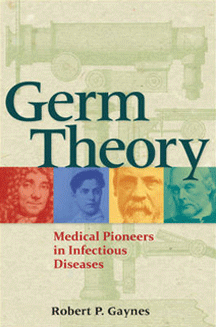By Germaine Cornelissen-Guillaume
Robert P. Gaynes succeeds in depicting in large brushes the history of infectious diseases, placed into the context of concepts and ideas as they evolved from the time of Hippocrates in ancient Greece 2,500 years ago to the present. He does so by presenting lively biographies of twelve pioneers selected for changing the prevailing view of the time and for contributing major advances in the understanding, diagnosis, prevention, and treatment of infectious diseases. One appealing aspect of the book lies on the personal background of each individual, providing insight on how upbringing and world affairs affected the way discoveries were made and progress achieved. A portrait of the twelve scholars and their character helps the reader understand what it took to overcome preconceived ideas and why some important innovations failed to enter current practice until much later. The book’s captivation also stems from Gaynes’ description of contemporaneous innovations in other fields such as the appearance of medical schools and hospitals, advances in anatomy (Vesalius’ dissection of cadavers), and the broader dissemination of information with the advent of the printing press.
I found the story of Avicenna particularly fascinating. This brilliant scholar who lived a tumultuous life was way ahead of his time when he postulated the contagious nature of tuberculosis in his Canon of Medicine. But prejudice tragically prevented Western medicine from embracing this innovation that countered the then prevailing Galenic view that disease was internal to the human body. The concept of contagion would resurface only during the Renaissance with Girolamo Fracastoro who witnessed the beginning of a syphilis outbreak and its terrifying effect on the population.
While most biographies are from physicians, there are exceptions. Antony van Leeuwenhook was a draper with great skills for making microscopes of great magnification power to which he added light to illuminate carefully prepared specimens, allowing for the first time the observation of bacteria and other single-celled organisms. Louis Pasteur was a chemist and Lillian Wald a nurse whose contributions served as the underlying foundation of the public health infrastructure.
A large part of the book is devoted to advances achieved between the second half of the eighteenth century and the beginning of the twentieth century. For contributions to the prevention of infectious diseases, Gaynes singles out work by Edward Jenner (smallpox vaccination), Ignaz Semmelweis (statistics used to show that hand washing reduced childbed fever), Louis Pasteur (immunity to microorganisms by attenuation of pathogenic microbes), Robert Koch (bacteriological causes of disease), and Joseph Lister (antiseptic surgery). His biographies of Paul Ehrlich (antibody production) and Alexander Fleming (penicillin) illustrate major breakthroughs in the treatment of infectious diseases. Despite these advances, the author cautions against complacency and highlights some of the challenges ahead. Even today, scourges such as cholera are not completely eradicated and may recur in cycles, as Alexander Chizhevsky proposed by revealing associations with space weather, another factor usually dismissed in the West but worthy of further investigation.
This is a fascinating book that will captivate anyone with an interest in microbiology, infectious disease, and medical history.
Germaine Cornelissen-Guillaume is a professor of integrative biology and physiology and co-director of the Halberg Chronobiology Center at the University of Minnesota, Twin Cities.




